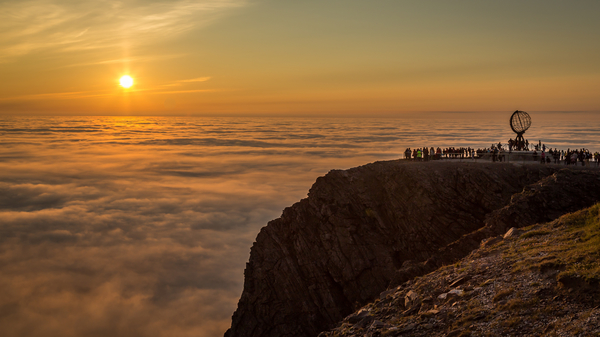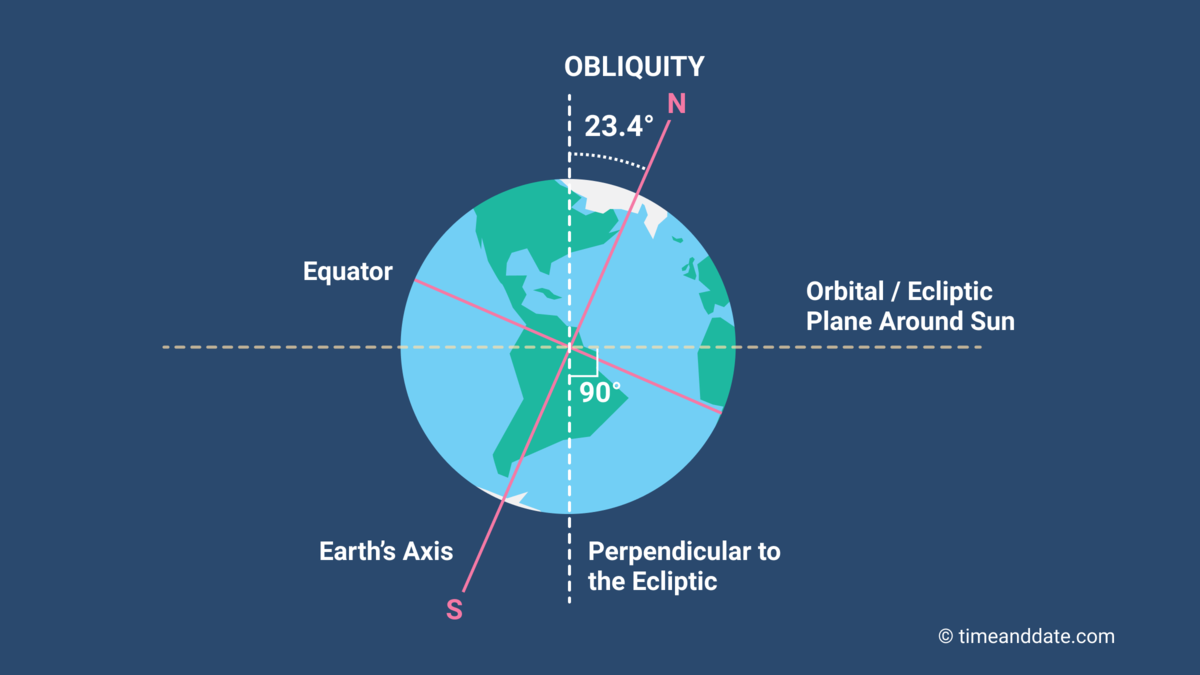What and When Is the Midnight Sun?
The Midnight Sun—also known as polar day—refers to an extended period of daytime that lasts 24 hours or more. The phenomenon occurs in or near the Arctic and Antarctic regions during summer.

The Midnight Sun at Nordkapp in Norway.
©iStockphoto.com/Pedal-Power-Photos
The moments when 99% of people see sunlight
Roughly speaking, every place on Earth spends half the year in daytime, and half the year in nighttime. At the equator, the periods of daytime and nighttime are more or less equal—about 12 hours each—throughout the year.
As you move away from the equator, the balance changes every day. In New York City, for example, daytime lasts about 15 hours in June, and around 9 hours in December.
Eventually, as you get close to the North Pole or South Pole, periods of daytime and nighttime can last a full 24 hours. This phenomenon is called polar day and polar night. The popular term for polar day is the Midnight Sun.
What Causes the Midnight Sun?
The Midnight Sun is a result of the Earth's tilt.


The Earth spins at a tilted angle.
timeanddate.com
The Earth spins once a day on its axis of rotation, an imaginary line joining the North Pole and South Pole. This is why the Sun appears to rise and set every day.
In addition, the Earth orbits the Sun once a year. As it does so, it traces out an imaginary plane (a flat surface, like a disk) around the Sun. This is known as the ecliptic plane.
However, the Earth's equator is not aligned with the ecliptic plane. It is tilted by 23.4 degrees. This is called the obliquity of the ecliptic, or the Earth's axial tilt.
As a result of this axial tilt, one of the Earth's poles is normally tilted toward the Sun, while the other is tilted away. This is what gives us our different seasons.
One Sunrise and Sunset a Year at the Poles


The North Pole and South Pole move in and out of sunlight as the Earth orbits the Sun.
©timeanddate.com
At the June solstice, the North Pole is pointed toward the Sun. No matter how much the Earth rotates, the Sun never appears to set, producing the phenomenon of the Midnight Sun. The South Pole, on the other hand, is in 24-hour darkness: polar night.
Six months later at the December solstice—when the Earth is on the other side of the Sun—the situation is reversed. Now the North Pole is pointed away from the Sun, and the Sun does not rise at all. Meanwhile, the South Pole is bathed in the continuous sunlight of polar day.
The March equinox, when neither pole is pointed more toward the Sun, is the time of sunrise at the North Pole, and sunset at the South Pole. Likewise, the September equinox brings sunset to the North Pole, and sunrise to the South Pole.
In other words, sunrise and sunset at the poles are caused not by the Earth's rotation, but by its orbit around the Sun.
Polar Day Happens Not Just at the Poles
At the June solstice, the entire Arctic region—the area enclosed by the Arctic Circle—is filled with the Midnight Sun. This includes parts of the US (Alaska), Canada, Greenland, Iceland, Norway, Finland, Sweden, and Russia.

Midnight Sun in Norrbotten, a province in the north of Sweden.
©iStockphoto.com/RolfAasa
The latitude of the Arctic Circle is approximately 66.6°N. This is equivalent to the latitude of the North Pole (90.0°N) minus the Earth's axial tilt (23.4°).
The closer a place is to the North Pole, the longer the period of polar day. In the northernmost city in Alaska, Utqiaġvik, the Sun stays above the horizon for about 82 days, from around May 11 to August 1. In the northernmost town in the world, Ny-Ålesund, on the Norwegian island of Spitsbergen, the Midnight Sun lasts for 131 days or so, from about April 17 to August 26.
The latitude of the Antarctic Circle is approximately 66.6°S, which encircles almost all of the continent of Antarctica.
Earth's Atmosphere Bends Light
Locations that are just outside the Arctic and Antarctic Circles also experience polar day. This is due to refraction, an optical effect where the light from the Sun is bent by the Earth's atmosphere. In other words, the Sun remains visible even though, in reality, it lies below the horizon.

Refraction has to be taken into account when working out the times of sunrise and sunset.
©timeanddate
For instance, Stevens Village in Alaska is about 60 km south of the Arctic Circle. Nevertheless, it enjoys Midnight Sun for approximately 17 days, from about June 12 to 29.
The Arctic and Antarctic Circles Are Shrinking
In a cycle that lasts approximately 40,000 years, the Earth's axial tilt oscillates by a couple of degrees. At the moment, the tilt angle is decreasing from about 24.2° (9,500 years ago) to 22.6° (10,200 years from now).
This oscillation means the latitudes of the Arctic Circle and Antarctic Circle are moving closer to the poles by about 14 meters per year.
For the Icelandic island of Grímsey, which lies about 40 km north of the mainland, this movement has a notable consequence. The Arctic Circle currently runs through the northernmost tip of the island, but by the middle of this century, that will no longer be the case. Still, thanks to the effect of refraction, Grímsey will continue to enjoy the Midnight Sun for about 30 days every year, from around June 6 to July 6.
White Nights
Even when the Sun has set below the horizon, the sky remains light during the period of twilight. Nights where the sky never becomes fully dark are known as white nights.

Saint Petersburg in Russia holds a White Nights Festival from May to July.
©iStockphoto.com/Mikhail Proskalov
For instance, the island of Unst—part of the Shetland Islands in the UK—is roughly 700 km south of the Arctic Circle. However, from about June 14 to 28, the Sun never gets more than six degrees below the horizon. During this period, the island has a daily helping of around 19 hours of daylight, and 5 hours of civil twilight.